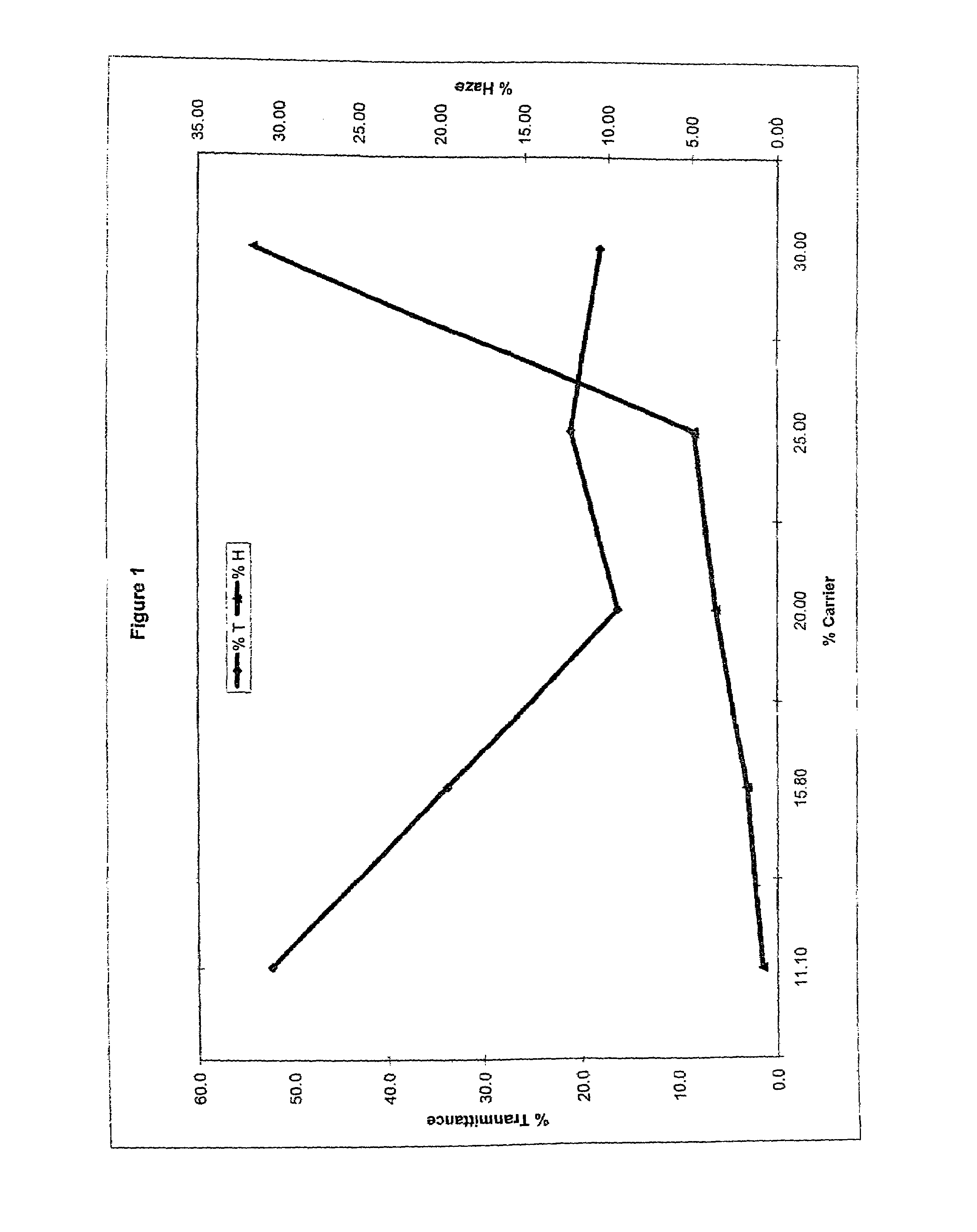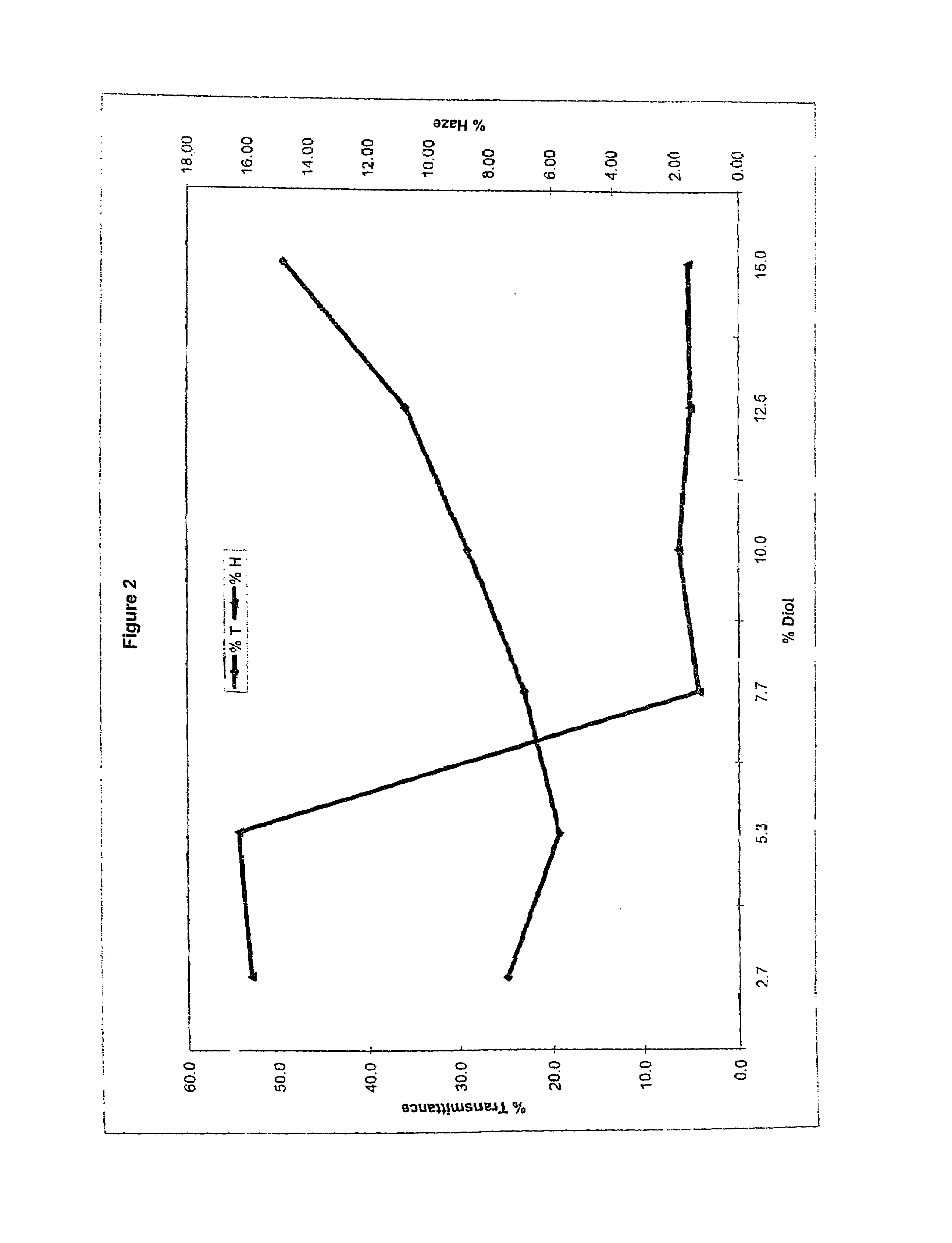Method of dyeing a plastic article
a plastic article and dyeing technology, applied in the dyeing process, other domestic articles, instruments, etc., can solve the problems of insufficiently and sufficiently dispersing the colorant required, the direct incorporation method is not particularly well suited to the preparation of molded articles, and the colorant is substantially distributed throughout the molded articl
- Summary
- Abstract
- Description
- Claims
- Application Information
AI Technical Summary
Benefits of technology
Problems solved by technology
Method used
Image
Examples
examples
[0097]In the following examples, each dye bath was prepared by mixing deionized water, carrier and diol together in a mixing tank, thus forming a liquid mixture having a total weight of 26,986 g. The liquid mixture was passed continuously at a temperature of 95° C. through a bag filter into which 50 grams of dye had been previously placed. The heated mixture containing dye was cycled from the mixing tank through the bag filter and back to the mixing tank for a period of time sufficient to saturate the mixture of water, carrier and diol with dye, and thus form the dye bath. The dye bath was recycled back to the mixing tank through small openings (having diameters of 4.8 mm) to enhance turbulent mixing of the dye bath during dyeing operations.
[0098]The initial cycling, for purposes of forming a saturated dye bath, was performed for a period of approximately 60 minutes. The dye bath was then continuously cycled through the above described system at a temperature of 95° C., and at a rat...
examples 1 – 5
Examples 1–5
[0100]In the following examples, the levels of water and carrier were each modified, while the level of diol was maintained between 10 and 11 parts by weight. The dye used in each of examples 1–5 was MACROLEX Blue 3R dye, which was obtained commercially from Bayer Chemicals Corporation. The parts by weight of water, carrier and diol, based on 100 parts, for the dye bath compositions of examples 1–5 are summarized in the following Table 1.
[0101]
TABLE 1ExampleWaterCarrier(a)Diol(b)177.811.111.1273.715.810.5370.020.010.0465.025.010.0560.030.010.0(a)The carrier was ethyleneglycol mono-butyl ether.(b)The diol used was diethylene glycol.
[0102]Clear test specimens of molded thermoplastic polycarbonate having dimensions of 5 cm×7.5 cm×0.25 cm were immersed in the dye bath for a period of 3 minutes. The thermoplastic polycarbonate used was MAKROLON 2600 homopolycarbonate, which is based on bisphenol A, having a MFR value of 10 to 12 g / 10 minutes (as determined in accordance with ...
examples 6 – 11
Examples 6–11
[0105]In examples 6–11 the ratio of water to carrier was maintained in the range of 3.3 to 3.5, while the level of diol was modified. The dye used in each of examples 6–11 was MACROLEX Blue 3R dye, which was obtained commercially from Bayer Chemicals Corporation. The dye baths of examples 6–11 were prepared in substantially the same way and using the same equipment as with examples 1–5. The parts by weight of water, carrier and diol, based on 100 parts, for the dye bath compositions of examples 6–11 are summarized in the following Table 3.
[0106]
TABLE 3ExampleWaterCarrier(a)Diol(b)675.721.62.7773.721.15.3871.820.57.7970.020.010.01068.520.012.51165.020.015.0
[0107]Clear thermoplastic polycarbonate test specimens having the same dimensions, compositions and physical properties as those described in examples 1–5 were used. The clear thermoplastic polycarbonate test specimens were dyed under the same conditions as described in examples 1–5. The dyed plastic articles were obse...
PUM
| Property | Measurement | Unit |
|---|---|---|
| temperature | aaaaa | aaaaa |
| wavelength | aaaaa | aaaaa |
| wavelength | aaaaa | aaaaa |
Abstract
Description
Claims
Application Information
 Login to View More
Login to View More - R&D
- Intellectual Property
- Life Sciences
- Materials
- Tech Scout
- Unparalleled Data Quality
- Higher Quality Content
- 60% Fewer Hallucinations
Browse by: Latest US Patents, China's latest patents, Technical Efficacy Thesaurus, Application Domain, Technology Topic, Popular Technical Reports.
© 2025 PatSnap. All rights reserved.Legal|Privacy policy|Modern Slavery Act Transparency Statement|Sitemap|About US| Contact US: help@patsnap.com



